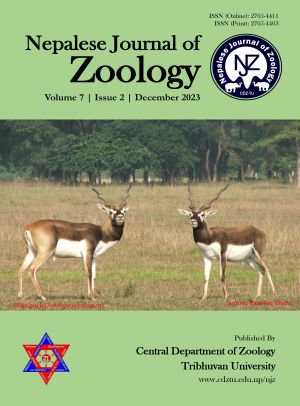Chital's call: An appeal for conservation strategies in the forest of the Institute of Forestry, Hetauda, Nepal
DOI:
https://doi.org/10.3126/njz.v7i2.60809Keywords:
Axis axis, Population estimation, Pellet group count, Habitat preferences, ThreatsAbstract
The chital, Axis axis, constitutes one of Nepal's six deer species and maintains a closed population within the forest of the Institute of Forestry, Hetauda Campus. Presently, the chital population faces a range of challenges, prompting a comprehensive study encompassing population status, habitat preference analysis, and threat assessment. We utilized the pellet group count method on 74 systematic random sample plots (4×4m) within a 100×100 m grid for population estimation. Pellet presence/absence in predetermined habitat characteristics was analyzed to assess habitat preferences. Concurrently, a relative threat ranking method from household interviews was employed to evaluate existing threats. The study revealed a total chital population estimate of approximately 141 individuals, with a population density of 190 individuals per km2. Their habitat preference showed an affinity towards areas abundant in Sal and riverine forests, along with an inclination towards locations further from roads within the forested areas. Primary threats to the chital population encompassed attacks from feral dogs, illegal hunting, and habitat degradation mainly due to invasive alien plant species. This study shows that with effective management of the feral dogs, mitigation strategy to control illegal hunting with the help of local authorities, and improving the habitat conditions concerning their preferences, the chital population has the potential to continue growing in the coming years.
Downloads
Downloads
Published
How to Cite
Issue
Section
License

This work is licensed under a Creative Commons Attribution-NonCommercial 4.0 International License.
This license enables reusers to distribute, remix, adapt, and build upon the material in any medium or format for noncommercial purposes only, and only so long as attribution is given to the creator.

